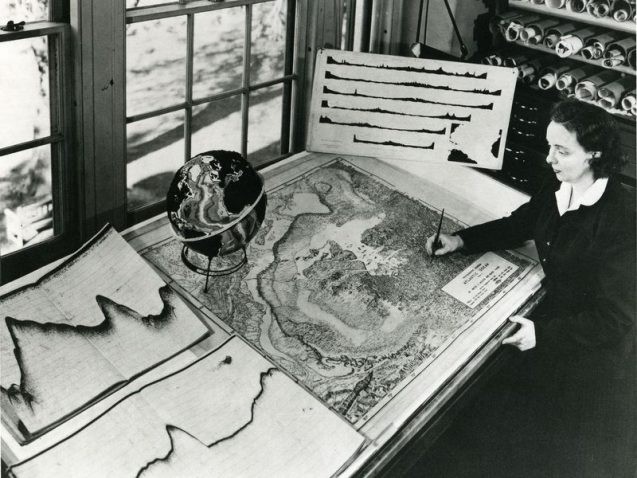Join Us in Celebrating #MarieTharp100
July 30 marks 100 years since the birth of Marie Tharp, a pioneering geologist who created some of the first maps of the ocean floor. We’re celebrating her achievements and legacy with blog posts, giveaways, and more.

July 30 marks 100 years since the birth of Marie Tharp, a pioneering geologist and cartographer who created some of the world’s first maps of the ocean floor.
In 1949, when Tharp began working at the Lamont Geological Observatory (now the Lamont-Doherty Earth Observatory at Columbia University), very little was known about the structure of the seafloor; it was thought to be mostly flat and featureless. But when Tharp and her colleague Bruce Heezen published the first map of the Atlantic in 1957, Tharp’s drawings revealed that the seafloor is instead covered in canyons, ridges, and mountains. Over time, her maps revealed the existence of the mid-ocean ridges, a series of mountain ranges that extend over 40,000 miles around the globe. In 1977, Tharp and Heezen published the first complete world map of the ocean floors. Their work helped to prove the theory of plate tectonics, the idea that the continents move over time, which was controversial until then. The discovery revolutionized our understanding of how nearly everything on the planet works.
Tharp began her career at a time when few women became scientists. Because of her gender, she wasn’t even allowed on the ships that collected the seafloor data that she used to make her maps; she didn’t set foot on a research cruise until 1968. Her early evidence of seafloor spreading was dismissed as “girl talk.”
Today, Marie Tharp is recognized for the revolutionary that she was. In 1997, the Library of Congress named her as one of the four greatest cartographers of the 20th century. She died of cancer in 2006 at the age of 86, but her legacy lives on in the countless women scientists she has inspired.
For the week leading up to her birthday, Lamont-Doherty and the Earth Institute will be celebrating Marie Tharp’s achievements and legacy with blog posts, webinars, giveaways, and more. Check out our lineup below to see how you can learn more and get involved.
Note: Links will be added and updated as content becomes available.
Join us on social media.
Follow the #MarieTharp100 hashtag for great images and fun facts about this pioneering, underrated cartographer. Post your own Tharp-inspired reflections, artwork, or music using the hashtag for a chance to win a copy of Ocean Speaks, a new picture-book biography about Tharp.
Read Ocean Speaks with us.
In a video, Maureen Raymo, interim director of Lamont-Doherty Earth Observatory, reads Jess Keating’s book, Ocean Speaks: How Marie Tharp Revealed the Ocean’s Biggest Secret in front of one of Tharp’s history-making maps. In another video, Raymo explains why remembering Marie Tharp is important.
Check out our blog posts.
State of the Planet will share a story where Marie Tharp describes in her own words how she came to be a scientist, and what it was like to be at the forefront of seafloor mapping. We will also have a post about the impacts that Tharp’s work continues to have in the science world, and a roundup of surprising facts about her.
Visit our new website celebrating Marie Tharp.
Find all things related to Tharp’s life and work in one place. Learn about her story, scientific legacy, work inspired by her, and more in this growing collection.
Download a Marie Tharp Zoom background.
Make a statement in your next meeting by using one of these three gorgeous Marie Tharp maps as your background.
Tune in to our podcast.
Pod of the Planet interviewed Lamont oceanographer Vicki Ferrini, whose Seabed 2030 project is picking up where Marie Tharp left off.
Learn how to use maps for storytelling.
On July 27 at 1pm ET, a Thriving Online workshop will explore the storytelling power of cartography with Vicki Ferrini, senior research scientist at the Columbia’s Lamont-Doherty Earth Observatory, and Dawn Wright, the chief scientist at the global data giant ESRI and a veteran ocean explorer.
